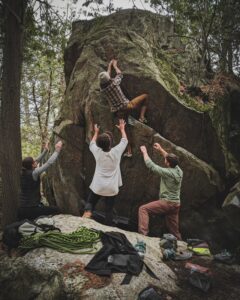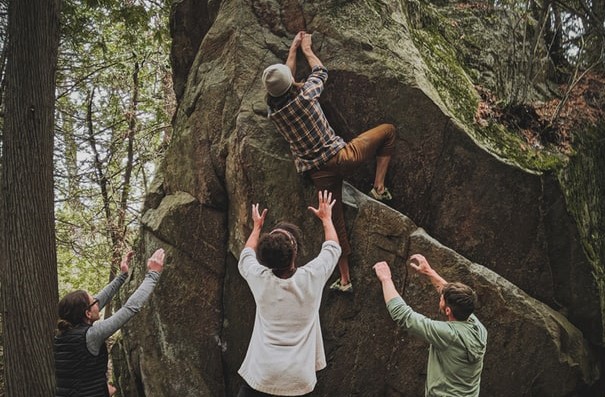Spotting for bouldering is not as easy as lifting your arms in the air and shouting ‘come on’ or ‘Allez’. There are a number of rules that guide the process. A good spotter is someone who pays attention and minimises risk for the boulderer. We’ll have a deeper look now.
What is Spotting for Bouldering?
A spotter is a boulderers safety net. A good spotter will reduce the chance of injury by ensuring that the climber does not fall in a bad or awkward way. Basically, the aim is to get the climber to land on their feet, or at least feet first. Protecting the head and spine is paramount.
Furthermore, once the climber lands, the spotter can then guide them safely to a standing position, especially if they are off-balance. A spotter should not ‘catch’ a climber, instead, they use the boulderers momentum to simply guide or reduce the falling momentum.
In essence, spotting whilst bouldering is a safety net. It does not guarantee an injury-free climb. Even so, a good spotter allows a climber to concentrate on the climbing or bouldering at hand, and hey can push that extra percentage harder.
Spotting for Bouldering: Outside
Obviously, spotting when bouldering is essential when you are outside. The development of crash pads has improved safety for climbers ten-fold. Even so, injuries can and do still happen.

This is where the spotter can help. It must be noted, however, that depending on the type of bouldering problem different techniques need to be employed.
Overhangs and Steep Boulders
It is essential that the fall area is covered with adequate padding. This should be assessed before the problem is even attempted. Once this is in place, you can then spot a climber when they attempt a problem.
On an overhang, the climber will generally fall off-balance. Therefore, you may need to adjust the trajectory of the fall. In this case, stand with your arms raised and attempt to catch the climber under the armpits as they fall.
Here the aim is to guide them so their feet touch the floor first, you should never attempt to catch them like a ball!
Slabs and Lower Angle Problems
These kinds of problems require a different technique. Why? Because, the fall tends to be more of a slide, instead of a clean break. Therefore, a spotters job will be to guide the climber away from the wall in a safe manner.
The spotter should aim to catch the climber around their hips. Guide them gently away from the wall, whilst ensuring they stay upright. It’s easy for the boulderer to be overstretched hear, so make sure you watch out for flailing arms and legs!
Highball Problems: Use a Team
At some point, a boulderer will climb too high to spot safely. Even so, this is usually offset by having a spotting ‘team’. Two or more spotters must talk beforehand and plan how they will attack the spot.
It is essential to adjust the trajectory of the falling climber. Usually, you will need to plan with your partner(s) and discuss who will cover which area. As the falling range is larger than lower climbs, one spotter will only be able to cover a certain area. Thus, why a team is employed.
Once more, the aim here is to guide the climber to land with their feet. Even though at that height, injuries will most likely occur.
Spotting Indoors
When bouldering in a gym, spotting is no different. Many climbers get complacent, as the indoors feels inherently safer. This is definitely the case, as the mats are thicker and gyms are designed with safety in mind.
Nevertheless, it does not hurt to use precaution, especially when attempting those harder graded boulder problems. The spotting techniques are very much the same as those we use for the outdoors.
We encourage best practices. Even if you do not think spotting your bouldering partner is necessary, it does not harm to give it a go. We boulder inside, to train for the outside, and spotting should not be any different.
Key Things to Watch Out for When Spotting for Bouldering
In order to encourage safe spotting when bouldering, we have collated a short list of things that you should think about before partaking in spotting. Always have these in mind when you are at the crag or in the gym.
- Assess the area for obstacles and plan how you would react in a fall
- Look at the potential fall trajectory and stand in the appropriate place
- Legs apart and knees bent – the spotting position helps you brace for impact
- Always concentrate, do not get distracted, a split second is all it takes
- Be prepared to move – the path of climb may force you to
- Ask for help if you feel you need it
- The job is only complete when the boulderer is safely back on the ground
By following these key tips, you should be able to go forth in your spotting career with confidence. Bouldering is an inherently dangerous sport, so having a good spotter is essential to safety.
What Can the Boulderer Do to Help Spotting
Falling in the correct way will help your spotter immensely. We have written a guide on how to fall when bouldering, and you should follow the steps we have highlighted here.
Try and direct your feet to the ground. If you feel like you are going to fall, try and give a warning shout so your spotter is alert.
Spotting Does Not Guarantee 100% Injury Free Climbing
As we all know, the sport of bouldering is inherently dangerous. Even though spotting is an essential aspect of safety it does not guarantee you prevention from injury. If you fall, you can always twist an ankle or break a bone.
This article is intended to give some advice. However, we do not claim to prevent you from getting injured. That is your sole responsibility. If you feel as though your spotting technique needs improvement ask for help and advice from other climbers. There’s no cutting corners when it comes to spotting.

